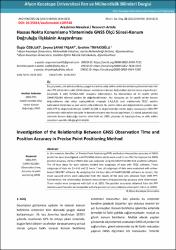Hassas nokta konumlama yönteminde GNSS ölçü süresi-konum doğruluğu ilişkisinin araştırılması
Künye
Özbulat, Ö. , Şafak Yaşar, Ş. & Tiryakioğlu, İ. (2022). Hassas Nokta Konumlama Yönteminde GNSS Ölçü Süresi-Konum Doğruluğu İlişkisinin Araştırılması . Afyon Kocatepe Üniversitesi Fen Ve Mühendislik Bilimleri Dergisi , 22 (4) , 814-823 . DOI: 10.35414/akufemubid.1105538Özet
Bu çalışmada, son yıllarda oldukça yaygın kullanıma sahip online nokta konumlama yöntemlerinden biri olan PPP yönteminin sabit GNSS istasyon noktalarının konum doğrulukları üzerine etkisi araştırılmıştır. Çalışmada 8 adet TUSAGA-Aktif istasyonu kullanılmıştır. Bu istasyonlara ait 24 saatlik veriler GAMIT/GLOBK bilimsel yazılımı ile değerlendirilmiştir. Her istasyona ait 24 saatlik veriler konum doğruluklarına olan etkiyi saptayabilmek amacıyla 2,4,6,8,12 saat aralıklarında TEQC yazılımı kullanılarak bölünmüş ve yeni veriler elde edilmiştir. Bu veriler online veri değerlendirme yazılımı olan CSRS-PPP ile değerlendirilmiştir. GAMIT-GLOBK ile değerlendirilen veriler doğru varsayılarak CSRS-PPP yazılımından elde edilen sonuçlar ile karesel ortalama hata hesabı yapılmıştır. Ek olarak çalışmada ölçü süresinin konum doğruluğu üzerine etkisi Eckl vd. 2001 çalışması ile karşılaştırılmış ve elde edilen sonuçların uyumlu olduğu görülmüştür. In this research, the effect of Precise Point Positioning (PPP) method on the position accuracy of GNSS points has been investigated and 8 TUSAGA-Active points were used. In an effort to improve the GNSS position accuracy, 24-hour RINEX data was evaluated using the GAMIT/GLOBK that academic software. The 24-hour datas for each stations divided into subgroups of data with TEQC software. These subgroups of data are 2-4-6-8 and 12 hours. Then, all subgroups of data were evaluated with online-based CSRS-PPP software. By accepting the 24-hour data of GAMIT/GLOBK software as correct, the mean squared errors were calculated from the results of the data sets obtained from CSRS-PPP. Furthermore, the relationships between measurement time/positioning accuracy were determined. These results were compared with Eckl et al. 2001. The position accuracies obtained from the PPP solutions were found to be compatible with the position accuracy relations obtained in Eckl et al. (2001).
Kaynak
Fen ve Mühendislik Bilimleri DergisiCilt
22Sayı
4Bağlantı
https://dergipark.org.tr/tr/pub/akufemubid/issue/72533/1105538https://hdl.handle.net/11630/11071



















